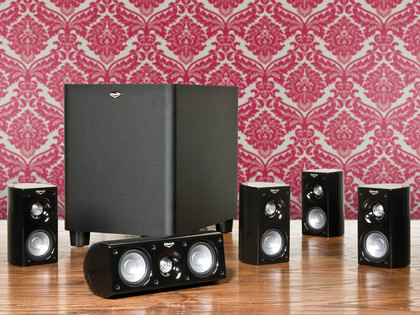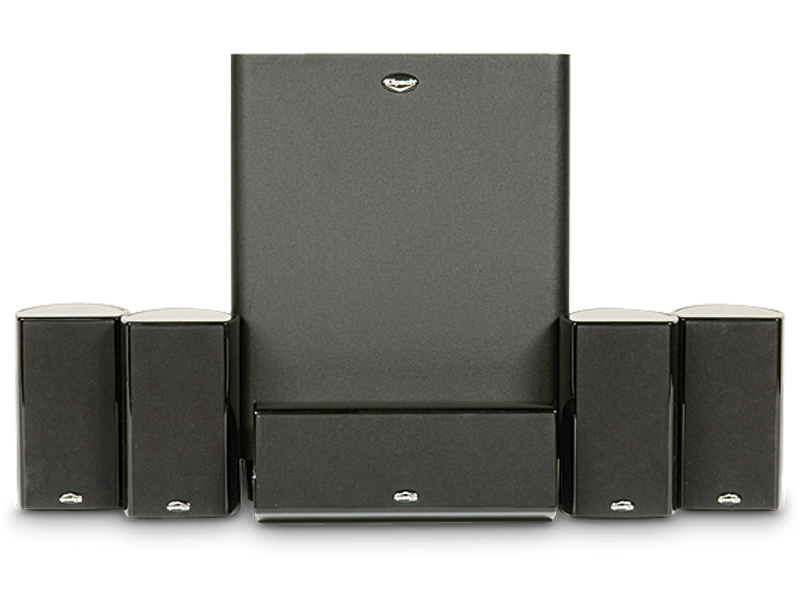TechRadar Verdict
If you're looking to build an affordable surround sound setup with more quality than an all-in-one system, then partner this with an entry-level AVR and enjoy
Pros
- +
Good detail and projection
- +
solid, well extended bass
Cons
- -
Slightly rough and edgy horn tweeters don't deliver high-quality audio reproduction
Why you can trust TechRadar
The popularity of this type of compact speaker package has mostly been driven by the switch from CRTs to flatscreen TVs.
For, while the case for flatscreen TVs is overwhelming on most counts, sound quality has suffered because even large flatpanels don't lend themselves to good acoustic design.
Subs in particular don't like being crammed into shallow enclosures, while satellite speaker design also suffers. The left and right speakers are too close to each other, and to the centre speaker, to give a wide spread of sound.
They are also hobbled by the single structure that surrounds them all, which acts as a sounding board, delivering a characteristically wishy-washy sound, with poor bass dynamics. This is where specialist producers such as Klipsch enter the fray.
This system is only available as a 5.1 package. You can't buy additional satellites if you want to build a 7.1 channel system, although I doubt that'll make a difference to most purchasers. The satellite speakers are fundamentally conventional in design, though there is real evidence of attention to detail.
All five satellites are based on sealed enclosures, made from robust heavy duty ABS mouldings, smoothly rounded at the sides and back, the shape helping increase stiffness. Centre speaker aside, the otherwise identical satellites are home to a single small bass/mid driver, plus a horn-loaded tweeter that generates a lot of grunt from very little input power.
However, Klipsch doesn't specify the sensitivity of the speakers (the quoted figure only refers to maximum output level). In any case the tweeter diameter is very small, which helps with upper frequency response, all other things being equal, and there are small diffusers in front of the treble domes, probably to counter the tendency of horns to be excessively directional.
The bass/midrange unit is tiny, but seemingly well made. The apparent source of sound from the tweeter and the bass/mid unit is coplanar, which should translate into more consistent imagery.
The centre speaker, which includes two bass drive units for increased power handling, is essentially a slightly larger version of the main satellite turned on its long side, which can be adjusted in its supplied cradle to optimise it for use above or below the TV. The other satellites also come with simple adjustable wall-mounting hardware.

Throbbing gristle
Finally, the subwoofer is a perfectly conventional active design, based on a small diameter bass unit, and a rather lightweight enclosure, which you can feel thrumming away through your fingertips. Adjustments are available for frequency coverage (low pass filter) level and phase reversal which provide the standard set of sound tweaking options.
On the whole it works well with some minor caveats. Sound quality is bold and outgoing for home cinema material, although I wouldn't trust it with an audiophile music collection, and the subwoofer is an excellent match to the rest of the system and is arguably its high point.
It has real muscle and moderately impressive depth and weight, if you take care to optimise the control settings and use some restraint. This one has the tautness and discipline necessary to make a good, seamless extension to the coverage of the satellites and so it matches the system well.
The satellites perform solidly near the crossover region to the sub, and this helps produce an impressively seamless join.
Don't expect true high-octane results, especially with soundtracks rich in dramatic effects, but it works commendably with more mainstream, and (dare I say) naturalistic material. Higher up the frequency band, the system begins to show some signs of weaknesses.
Klipsch is not demanding of amp power with its horn tweeters, and there is no shortage of treble output if you're sitting close to the main tweeter axis, but there is a trace of hardness and aggression here, too.
The Klipsch system has some excellent positive qualities, such as its consistent and even transitions across the sound stage and from front to back. The additional bass driver gives the centre channel more clout, too. The system also offers first-rate vocal intelligibility, which should come as a real relief to many users of flatscreen tellies.
For reasons best known to Klipsch, this package is described as HD Theater, transparently cashing in on the current preference for HD video. But don't be fooled; there is nothing remotely high-def about this system, unless you count the sometimes overcooked treble that helps emphasise fine detail (but not always in a good way).
But the Klipsch HD Theater 500 has plenty going for it. The speakers are relatively small, discreet and well built (the cheapskate use of spring terminals aside), and the system is also intelligible, detailed and open-sounding. If you're looking to build an affordable surround sound setup with more quality than an all-in-one system, then partner this with an entry-level AVR and enjoy
